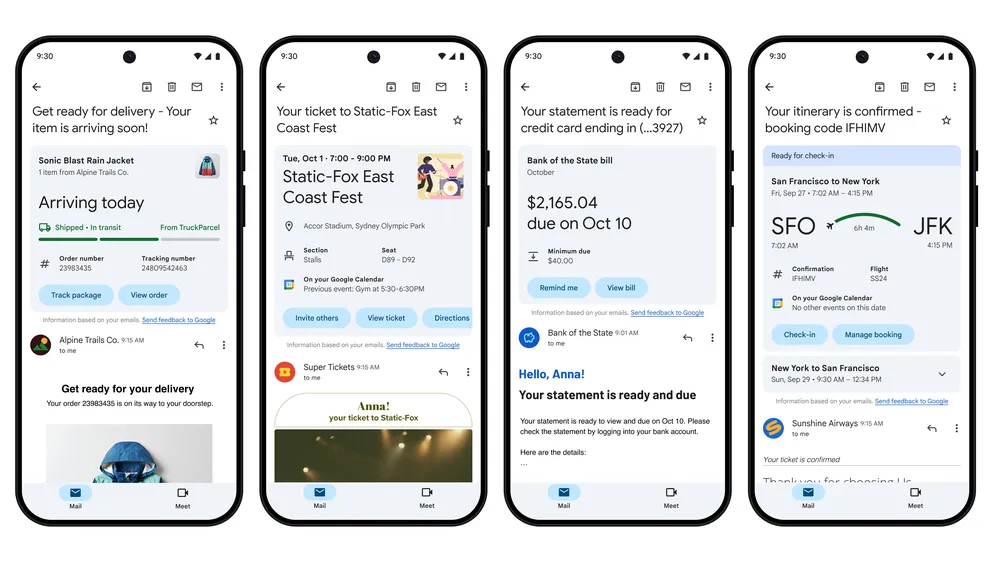In the ever-evolving landscape of email management, Google has announced an exciting upgrade to Gmail’s summary cards, aimed at improving user experience and streamlining inbox navigation. The latest enhancements, rolling out in October 2024, promise more dynamic and visually organized summary cards that provide real-time updates on purchases, events, bills, and travel plans.

Summary cards in Gmail show at the top of purchase, event, bill, and travel emails. Source: https://blog.google/products/gmail/new-gmail-summary-cards/
For those in the email marketing space, these changes represent more than just a UX improvement—they signal a shift in how information is delivered and accessed, with potentially significant implications for email deliverability.
Google’s enhanced summary cards are designed to declutter the inbox and ensure important information is easily accessible.
Here are the key updates:
Summary cards will now display real-time updates, such as package tracking, event reminders, or bill due dates. They are constantly refreshed, ensuring users always have the latest information at their fingertips.

An event summary card before and after. Now, summary cards are dynamic and it’s easier to view key details and take action. Source: https://blog.google/products/gmail/new-gmail-summary-cards/
Users can now take actions directly from these cards, like setting reminders for bills, adding events to their calendars, or tracking shipments—all without needing to search through multiple emails.
A new “Happening Soon” section will show relevant purchase cards when delivery dates are approaching. This feature provides a quick overview of important upcoming activities and will be populated with event, bill, and travel information in future updates.
The “Happening soon” section in your inbox will show purchase summary cards when the delivery date is two days away.
Source: https://blog.google/products/gmail/new-gmail-summary-cards/
[Update: October 10, 2025]
Building on the foundation of structured data and the Summary Cards detailed in this article, Google is once again evolving the Promotions Tab with a new feature: Deal Cards. This update represents the latest and most refined version of Google’s vision for a more interactive and structured inbox.
Deal Cards are rich, auto-generated summaries that appear at the very top of a promotional email, showcasing key offer details like the discount, expiration date, and coupon code. They may also include actionable buttons like “Visit site” and “Copy code,” creating a seamless experience for the user.
Just like their predecessors, Deal Cards are not automatic. They are enabled by adding specific schema.org markup – the DiscountOffer type – to the <head> section of your email’s HTML.
To ensure your Deal Card is generated successfully, the following properties must be correctly configured:
For full technical instructions, you can refer to the official Google Developers documentation.
Good news for EU senders: Although Gmail’s rich visual features like Product Carousel and Single Image Preview aren’t available in the European market yet, the new Deal Cards are already visible to users in the EU. This means that brands operating within the region can start benefiting from these interactive promotional snippets right away.
For businesses and marketers, these updates present both opportunities and challenges.
Let’s break down the implications:
The revamped summary cards prioritize important information from transactional emails, allowing users to access it more easily. As a result, emails with critical updates—such as shipping notifications or event reminders—are more likely to stand out. This could improve engagement rates as users are guided to take action directly from their inbox.
If you’re sending transactional emails, this is great news. More dynamic and prominent placement within Gmail could lead to higher open rates and better interaction with your content.
Google’s summary cards rely heavily on structured data to extract key information from emails. This means that marketers and businesses must ensure their emails are properly formatted using Schema Markup. Otherwise, your email might not display with a summary card, potentially reducing its visibility and effectiveness.

Source: https://developers.google.com/gmail/promotab
To stay competitive, businesses should ensure their email templates meet Gmail’s schema requirements. Implementing structured data, such as the OrderStatus or EventReservation schemas, can help ensure that your messages are formatted to take full advantage of these new dynamic features.
Gmail’s new summary cards offer significant opportunities for higher engagement, but they also raise the bar for email deliverability. Poorly structured emails that fail to trigger these summary cards risk reduced visibility and deliverability over time. Ensuring that emails are properly formatted with schema markup and authenticated with protocols like SPF, DKIM, and DMARC is critical. Emails lacking these technical safeguards may not display summary cards and could be deprioritized in users’ inboxes, negatively impacting their reach.
Dynamic content plays a crucial role in improving deliverability. Emails that offer immediate value—such as package tracking updates or bill payment reminders—are more likely to be opened and interacted with. Gmail’s summary cards provide users with actionable information directly within the inbox, boosting engagement rates. Higher interaction rates lead to better email performance, stronger deliverability, and improved inbox placement.
Additionally, these enhanced summary cards help reduce spam complaints. When users receive timely and relevant information, they are less likely to mark emails as spam. By delivering valuable content that meets users’ needs, senders reduce spam complaints, which further enhances their sender reputation. A strong sender reputation is essential for maintaining good inbox placement and ensuring future emails continue to reach their intended audience effectively.
Understanding Email Sender Reputation And How It Affects Email Deliverability
Gmail tends to prioritize emails with high engagement rates, and the dynamic content featured in summary cards helps drive these metrics by making it easier for users to find value in their emails quickly. Summary cards offer users instant access to important information—such as package tracking, event reminders, and bill due dates—without the need to sift through multiple messages. This convenience encourages higher open rates, click-throughs, and interactions, all of which contribute to a stronger sender reputation.
High engagement metrics signal to Gmail that your emails are relevant and trustworthy, improving their deliverability and ensuring they land in the inbox rather than the spam folder. Additionally, the inclusion of summary cards for bills, purchases, and events fosters greater trust between sender and recipient. When users can quickly access and act on vital information, friction is reduced, and positive interactions are more likely. This transparency and timely communication not only boost engagement rates but also enhance the relationship between senders and recipients, further strengthening sender’s reputation and ensuring that future campaigns continue to perform well.
By combining dynamic content with a user-centric approach, marketers can build stronger trust with recipients, improve deliverability, and achieve sustained success with their email campaigns.
Maximize your email deliverability and security with EmailLabs!
Google’s latest updates to Gmail are designed to simplify user interactions with their inboxes, but they also raise the stakes for email marketers looking to maintain strong deliverability.
Here are some best practices to consider moving forward:
As Gmail continues to evolve, businesses and marketers must stay agile and adjust their strategies to ensure their emails stand out in the inbox and deliver value. With summary cards, Google is providing new ways to engage with users—but only for those who are prepared to meet the technical requirements and prioritize the user experience.
The future of email deliverability isn’t just about getting your message into the inbox; it’s about ensuring your message can be easily acted upon once it’s there.
We live in a world where your customers switch seamlessly between laptops, smartphones, and tablets. They navigate a complex digital ecosystem – checking emails, using mobile apps, and reacting...
We are delighted to announce that Vercom S.A., the company behind the EmailLabs project, has successfully completed the ISO 22301 certification process. This significant achievement underscores our commitment to...
EmailLabs, as part of the Vercom group, proudly announces its full commitment to aligning its ICT services with the latest cybersecurity standards. In response to dynamically changing regulations, the...
We are pleased to announce that MessageFlow, a product from the Vercom S.A. group, has received the prestigious CSA (Certified Senders Alliance) Certification. This recognition not only underscores the...
Best practices, Email Marketing, Pytania i odpowiedzi
Mail merge combines a template document with data to create personalized communications. This technique saves time by automatically generating individualized letters, emails, and labels without manual entry. What Is...
IT & Tech, Pytania i odpowiedzi, Technical
When an email travels from sender to recipient, it passes through several critical components of email infrastructure. At the heart of this journey sits the Mail Transfer Agent (MTA)...
Best practices, Deliverability, Google and Yahoo's Requirements, Pytania i odpowiedzi
The world of email marketing is constantly evolving, and leading mail service providers – Gmail, Yahoo, Microsoft, and Apple – regularly update their guidelines for senders. In recent years,...
Best practices, Email Marketing, Pytania i odpowiedzi
Mail merge combines a template document with data to create personalized communications. This technique saves time by automatically generating individualized letters, emails, and labels without manual entry. What Is...
IT & Tech, Pytania i odpowiedzi, Technical
When an email travels from sender to recipient, it passes through several critical components of email infrastructure. At the heart of this journey sits the Mail Transfer Agent (MTA)...
Best practices, Deliverability, Google and Yahoo's Requirements, Pytania i odpowiedzi
The world of email marketing is constantly evolving, and leading mail service providers – Gmail, Yahoo, Microsoft, and Apple – regularly update their guidelines for senders. In recent years,...
Gmail, Google and Yahoo's Requirements
You might have noticed a new item in your Gmail sidebar recently – the “Manage subscriptions” tab, often flagged with a blue notification dot. While Google announced this feature...
IT & Tech, Pytania i odpowiedzi, Technical
Efficient email communication isn’t just about sending messages — it also involves integrating email functionality into your business systems and applications. Email APIs (Application Programming Interfaces) serve as the...
One of the most important yet often underestimated elements in shaping a company’s brand perception is the transactional email. In e-commerce, the design of such messages must be carefully...
Google and Yahoo's Requirements, Yahoogle
2024 brought fundamental changes to email marketing, introducing new, stringent requirements for senders. Since February 1, 2024, Google and Yahoo have started enforcing new deliverability rules, primarily targeting bulk...
We live in a world where your customers switch seamlessly between laptops, smartphones, and tablets. They navigate a complex digital ecosystem – checking emails, using mobile apps, and reacting...
Are your campaigns not engaging all recipients as you expect? Do they fail to open your emails or click on links, lowering your campaign effectiveness and email marketing ROI?...